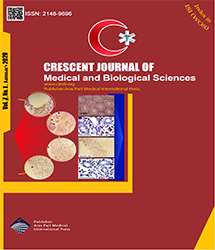
| Review | |
| Investigating the Duration of Exclusive Breastfeeding, the Challenges Ahead, and Methods of Extending the Lactation Period in Drug-Addicted Mothers: A Review Study | |
| Fereshteh Sadeghi1, Monir Ramezani2,3, Nayere Kargarkakhki4, Gholam-Hosein Zarifnejhad5 | |
| 1School of Nursing and Midwifery, Mashhad University of Medical Sciences, Mashhad, Iran 2Nursing and Midwifery Care Research Center, Mashhad University of Medical Sciences, Mashhad, Iran 3Department of Pediatric Nursing, School of Nursing and Midwifery, Mashhad University of Medical Sciences, Mashhad, Iran 4School of Nursing and Midwifery, Mashhad University of Medical Sciences, Mashhad, Iran 5Department of Community Health and Psychiatric Nursing, School of Nursing and Midwifery, Mashhad University of Medical Sciences, Mashhad, Iran |
|
|
CJMB 2020; 7: 7–16 Viewed : 4760 times Downloaded : 7567 times. Keywords : Neonatal abstinence syndrome, Drug-addicted mothers, Exclusive breastfeeding, Continued breastfeeding, Breastfeeding barrier |
|
| Full Text(PDF) | Related Articles | |
| Abstract | |
Objectives: The prevalence of drug abuse among pregnant women is increasing worldwide, putting their infants at the risk of many disorders. Neonatal abstinence syndrome (NAS) is considered as a neurological disorder in infants who are exposed to narcotics during pregnancy. Breastfeeding is implicated to markedly reduce the incidence and severity of the NAS, as well as the need for therapeutic agents. Therefore, the present study aimed to investigate the duration of exclusive breastfeeding and the hospital stay of infants with NAS, as well as the challenges ahead and solutions to extend the lactation period in drug-addicted mothers. Methods: A number of review articles indexed in PubMed, Google Scholar, and Medline databases were scrutinized in this study. The chosen review articles surveyed experimental/quasi-experimental studies that were published during 2004-2018 using keywords including NAS, drug-addicted mothers, exclusive breastfeeding barriers, and continued breastfeeding. Results: According to the results, the duration of continued breastfeeding in drug-addicted women was short and it failed in the frst six months after delivery. The critical factors interfering with continued breastfeeding were categorized into individual, family, and social barriers. In addition, social barriers consisted of fear and misconception about lactation, the lack of awareness and motivation, along with the lack of family support and health care centers. The fndings suggest that mother’s training during the pregnancy, mother-infant rooming-in, and mother-infant skin-to-skin contact could be potentially applied to extend the duration of the lactation in drug-addicted pregnant women. Conclusions: In general, hospitals should provide a comfortable environment to encourage drug-addicted women to breastfeed infants with the NAS. It seems that providing resources and facilities where drug-addicted women could discuss barriers to breastfeeding, as well as gaining access to lactation counselors and other professional practitioners would help mothers to continue breastfeeding. |
Cite By, Google Scholar
Google Scholar
PubMed
Online Submission System
 CJMB ENDNOTE ® Style
CJMB ENDNOTE ® Style
 Tutorials
Tutorials
 Publication Charge
Medical and Biological Research Center
About Journal
Publication Charge
Medical and Biological Research Center
About Journal
Aras Part Medical International Press Editor-in-Chief
Arash Khaki
Deputy Editor
Zafer Akan


















